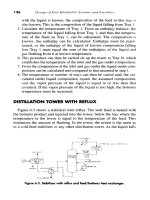Know and Understand Centrifugal Pumps Episode 1 pps
Bạn đang xem bản rút gọn của tài liệu. Xem và tải ngay bản đầy đủ của tài liệu tại đây (328.63 KB, 17 trang )
Know
and
Understand
CUSTODIO
c
Know and
Understand
Cen tr
if
ug
a
I
Pumps
Know and
Understand
Cent
r
if
u
g
a
I
Pumps
by Larry Bachus and
Angel Custodio
ELSEVIER
UK
USA
JAPAN
Elsevier
Ltd,
The Boulevard, Langford Lane, Cdlington, Oxford
OX5 lGB, UK
Elsevier Inc, 360
Park
Avenue South, New York,
NY
1001
0-
171
0,
USA
Elsevier Japan, Tsunashima Building Annex,
3-20-
12 Yushima,
Bunkyo-ku, Tokyo
11
3,
Japan
Copyright
0
2003
Bachus Company, Inc.
Published by Elsevier Ltd
All
rights reserved.
All rights reserved.
No
part of this publication may be reproduced, stored in
a
retrieval system
or
transmitted in any form or by any means: electronic,
electrostatic, magnetic tape, mechanical, photocopying, recording
or
otherwise,
without permission in writing from the publishers.
British Library Cataloguing in Publication Data
Bachus, Larry
Know and understand centrifugal pumps
1
.Centrifugal pumps
I.Title II.Custodio, Angel
62
1.6’7
ISBN 1856174093
No responsibility is assumed by the Publisher
for
any injury and/or damage
to
persons or property
as
a
matter
of
products liability, negligence or otherwise,
or
from any use or operation of any methods, products, instructions or ideas
contained in the material herein.
Published by
Elsevier Advanced Technology,
The Boulevard, Langford Lane, Kidlington, Oxford OX5 lGB,
UK
Tel: +44(0) 1865 843000
Fax:
+44(0)
1865
843971
Typeset by Land
&
Unwin (Data Sciences)
Ltd,
Bugbrooke
Printed and bound in Great Britain by Biddles Ltd, Guildford and King’s
Lynn
Contents
Prologue
About
the
Authors
1
Basic Pump Principles
Introduction
How
do pumps work?
Pressure measurement
Atmospheric pressure (ATM)
Absolute pressure (psia)
Gauge pressure (psig)
Vacuum
Pump head
Specific gravity
Pressure measurement
Pressures inside
the
pump
2
NPSH,
Net
Positive Suction Head
Introduction
Definition of NPSHr (required)
Definition NPSHa (available)
3
Cavitation
Introduction
Vapor pressure
Cavitation
The effects of vapor pressure on pump performance
Cavitation: A practical discussion
Review for preventing cavitation
xi
xlll
1
1
1
4
4
4
5
5
5
6
6
7
12
12
13
14
24
24
24
25
25
26
35
Contents
Cavitation review
Do
something about cavitation!
4
The
Affinity
Laws
Introduction
The Laws
The Affinity Laws and the impeller diameter
What’s the practical application of
these
laws?
5
Useful
Work
and
Pump
Efficiency
Useful work from a pump
Flow determination
Pump efficiency
Factors that affect the efficiency
Calculating pump efficiency
6
Pump
Classification
Introduction
Positive displacement pumps
Centrifugal pumps
Conceptual difference
Centrifugal volute pumps
Types of centrifugal pumps
Overhung impeller
Impeller between the bearings
Turbine pumps
Specific duty pumps
The typical
ANSI
pump
API (American Petroleum Institute) pumps
Vertical turbine pumps
Non-metallic pumps
Magnetic drive pumps
Canned motor pumps
Pump impellers
Turbine impellers
Conventional impellers
Suction specific speed,
Nss
Open impellers
Semi open impeller
Totally enclosed impeller
Wear bands
Specific speed,
Ns
37
37
39
39
39
42
42
44
44
46
48
48
50
51
51
51
54
55
56
57
57
57
58
58
58
59
60
61
62
63
64
65
66
66
70
71
71
72
73
Contents
7
Understanding
Pump
Curves
Pump performance curves
History
Head versus pressure
H-Q
Pump efficiency
The energy (BHp) curve
The pump’s minimum requirements (NPSH)
Special design pumps
Family curves
8
The System Curve
The system controls the pump
The elements of the Total Dynamic Head (TDH)
Determining the
Hs
Determining the Hp
Calculating the Hf and Hv
The dynamic system
Variable elevations
The happy zone
Dynamic pressures
Variable resistances
Short term resistance changes
Long term resistance changes
Pumps in parallel and pumps in series
Pumps in parallel
Three tips
Pumps running in series
Combined parallel and series pump operation
9
Shaft Deflection
Introduction
Operation, design and maintenance
Signs
of
shaft deflection
Interpreting the evidence
The sweet zone
The dual volute pump
76
76
77
77
78
80
81
82
85
85
92
92
92
96
96
97
110
110
113
113
116
116
117
120
122
123
124
125
128
128
133
136
137
140
141
vi
i
Contents
10
Pump
and
Motor Alignment
Introduction
Types of misalignment
Alignment techniques
Equipment alignment sequence
Coupling alignment
11
Bearings
Introduction
Bearing lubrication
Bearing failure
Bearing maintenance
Bearing seals
12
Pump
Shaft Packing
History
Vegetable fibers
Reciprocating action
Packing
Rotary action
Synthetic fibers
Compression packing
The lantern ring
The packing lubricant
Stages in
the
life of packing
13
Mechanical Seals
Pump packing
History
The mechanical seal
The single, unbalanced, inside mounted mechanical seal
The single, outside-mounted, unbalanced
seal
The single, balanced, internal mechanical seal
The single, balanced, external mechanical seal
Advantages of O-rings
The balance effect
Advantages of balance
Balance explained by math
Cartridge mechanical seals
Double seals
The tandem dual seal
The back-to-back double
seal
142
142
144
145
153
153
155
155
157
159
163
167
171
171
171
172
173
173
174
175
177
178
178
180
180
182
184
185
186
186
187
187
188
189
190
192
194
195
196
n
Vlll
Contents
The face-to-face dual seal
Support systems for dual seals
The thermal convection tank
The
turbo tank
The pumping unit
14
Failure Analysis
of
Mechanical Seals
Causes of premature seal failure
O-ring (the elastomer) failure
The elastomer sticks
to
the shaft
The
springs clog and jam
The shaft frets under the shaft seal
Incorrect installation dimension
Environmental controls for difficult sealing applications
Difficult pumping applications for mechanical seals
Environmental controls
Proper pump repair alignment methods
15
Common Sense Failure Analysis
Pump maintenance files
Failure analysis on centrifugal pumps
Why is this pump in the shop?
16
Avoiding Wear in Centrifugal Pumps
Introduction
Erosion
Corrosion
Wear rings
Fluid velocity accelerates wear
Turbulence
Throttling
17
Pump Piping
Introduction
Piping design
to
drain tanks and sumps
The Submergence Laws
197
198
198
199
200
202
202
204
209
210
21
1
212
213
2 14
215
222
226
226
227
228
232
232
232
233
233
235
235
236
238
238
238
243
Index
ix
248
Prologue
productive pump operation and contain maintenance costs. This
book
will serve as
a
guide
to
STOP
repairing industrial pumps.
About the Authors
Angel
Custodio
Angel specializes in the installation and imple-
mentation
of
Preventive Maintenance Systems
through his consulting engineering company formed
in
1987
in Puerto Rico. His installations have given
him the opportunity
to
look into different
approaches
to
hands-on maintenance and operator
I
mechanical components, computerized inventory
control and maintenance management.
He
is also a
member
of
ASME, and the Puerto Rican College of
Engineers.
I
c
inspections. Angel conducts seminars on pumps,
Know and Understand Centrifugal Pumps
/
\
r
I
\
suction piping. The fluid must be available
to
the pump with sufficient
energy
so
that the pump can work with the fluid’s energy. The pump
cannot suck on or draw the liquid into the pump. The concept of the
fluid being available
to
the pump is discussed in detail in Chapter
2
of
this book.
Positive displacement (I’D) pumps take the fluid at the suction nozzle
and physically capture and contain the fluid in some kind of moveable
enclosure. The enclosure may be a housing with a pulsing diaphragm,
or between the teeth of rotating gears. There are many designs. The
moveable enclosure expands and generates
a
low pressure zone,
to
take
the fluid into the pump. The captured fluid is physically transported
through the pump from the suction nozzle
to
the discharge nozzle.
Inside the pump, the expanded moveable enclosure then contracts
or
the available space compresses. This generates a zone of high pressure
inside the pump, and the fluid is expelled into the discharge piping,
prepared
to
overcome the resistance or pressure in the system. The
flow
that a PD pump can generate is mostly a function of the size
of
the
pump housing, the speed of the motor or driver, and the tolerances
between the parts in relative motion. The pressure or head that a PD
pump can develop is mostly
a
function of the thickness of the casing
and the tolerances, and the strength
of
the pump components.
As
the pump performs its duty over time, and fluid passes through the
pump, erosion and abrasive action will cause
the
close tolerance parts
to
wear. These parts may be piston rings, reciprocating rod seals,
a
flexing
diaphragm, or meshed gear teeth.
As
these parts wear, the pump will
lose its efficiency and ability
to
pump. These worn parts must be
changed with a degree of frequency based on time and the abrasive and
lubricating nature of the fluid. Changing
these
parts should not be
Basic Pump Principles
-
ROTATION
Fiaure
1-3
viewed as breakdown maintenance. Nothing is broken. This periodic
servicing is actually
a
production function
to
return the pump
to
its
best or original efficiency.
Centrifugal pumps also require that the fluid be available
to
the pump’s
suction nozzle with sufficient energy. Centrifugal pumps cannot suck or
draw the liquid into the pump housing. The principal pumping unit of
a
centrifugal pump is the volute and impeller.
(See
Figure
1-3).
The impeller is attached
to
a
shaft. The shaft spins and is powered by
the motor or driver.
We
use
the term driver because
some
pumps are
attached
to
pulleys or transmissions. The fluid enters into
the
eye
of
the
impeller and is trapped between the impeller blades. The impeller
blades contain the liquid and impart speed
to
the liquid as
it
passes
from the impeller eye toward the outside diameter of the impeller. As
the fluid accelerates in velocity, a zone of low pressure is created in the
eye
of
the impeller (the Bernoulli Principle, as velocity
goes
up,
pressure
goes
down). This is another reason
the
liquid must enter into
the pump with sufficient energy.
The liquid leaves the outside diameter of the impeller at a high rate of
speed (the speed of the motor) and immediately slams into the internal
casing wall of the volute. At this point the liquid’s centrifugal velocity
comes
to
an abrupt halt and the velocity is converted into pressure (the
Bernoulli Principle in reverse). Because the motor is spinning, there is
also rotary velocity. The fluid is conducted from
the
cutwater around
the internal volute housing in an ever-increasing escape channel.
As
the
pathway increases, the rotary velocity decreases and even more energy









